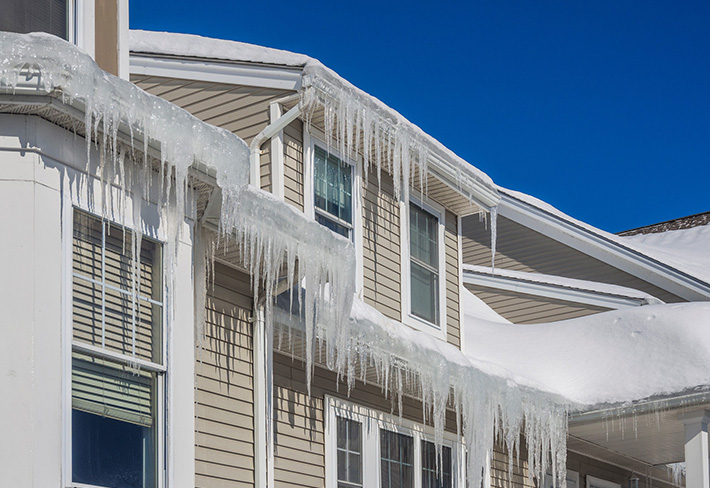Baby, it’s cold outside this winter. So, you can thank your lucky stars if you have a warm interior to protect you from the severe cold weather that Mother Nature may throw your way. While you may be nice and cozy inside, the exterior of your home is severely battered by snow, cold air, and ice in winter. As a result, you may have a serious problem brewing right under your roof, literally.
Ice dams could threaten your roof, causing severe damage to your roof sheathing and causing leaks inside your home.
Here is more insight into this roof problem that is prevalent when it snows and how to prevent and address it if you experience it.
How Ice Dams Form
Chances are, you probably have an unfinished attic, and your attic may also have minimal insulation. As a result, a chemical reaction may occur on your roof as the rising heat indoors collides with the icy winds, pummeling the exterior of your roof. This heating and thawing causes snow to turn to ice, creating ice dams as temperatures drop overnight.
If you step outside and look at what’s happening, you’ll see a ridge of ice forming near the edge of your roof near the facia. You may even see large, torpedo-shaped ice hanging over the gutter’s edge, waiting to strike any moment.
While falling, torpedo-shaped ice is indeed a threat, an even more significant threat may loom underneath the snow, ice, and slush mess on your roof. This ridge may damage the shingles, particularly if you have asphalt ones. As the snow melts and refreezes, it may push water upward and underneath the shingles, allowing moisture to penetrate the shingles and seep into the wood roof deck.
If ice forms on the roof over days, it could cause significant damage to the roof deck and allow water to leak into the attic. Left undetected, this could not only lead to roof damage but also encourage mold growth.
A Temporary Solution for Ice Dam Formation
When you notice an ice dam forming, you may be tempted to start chiseling away at the ice on the roof. Or you may try the “do nothing and let nature take care of it by melting it” approach. Both could prove to be detrimental. Using tools to knock away the ice may damage the roof shingles and sheathing. Letting nature take care of it may also cause damage if the ice dam sits for an extensive period.
If you notice an ice dam forming, it may be in your best interest to get rid of it using a softer, proactive approach. Get some ice-melting salt made from calcium chloride from your local hardware store, the kind you would use to clear ice on your driveways and porches. Stuff it in an old sock and throw it up on the roof where the dam forms. You may have to stuff and toss several socks on the roof. The salt will melt the ice and allow the water to flow away from the roof instead of under the shingles.
Heating cables can also help with melting ice. Ideally, you should have these installed professionally. When it snows, you plug these in, and it will help minimize an ice dam problem.
How to Prevent an Ice Dam
Tossing socks on the roof may be a temporary solution, but the long-term solution to this problem is attic insulation. When there is very little insulation in the attic space, the warm air in your home will collide with the cold air on the roof to create such dams. Proper insulation can prevent the roof from forming condensation, which will quickly form ice on the roof. Not only will you be helping to minimize roof damage, but you may even improve your energy bills by reducing air leaks and keeping your home even warmer in winter.
Frequently Asked Questions
Do ice dams only damage my roof sheathing?
No. Sometimes, ice dams can cause severe damage to your gutter if there is a substantial amount of ice present.
Should I eliminate ice from my roof using a hammer, ax, or some other tool?
No. Using such items to remove ice from the roof is not a good idea. Not only could you injure yourself, but you could also cause serious damage to your roof.
Will I be able to see the ice dam forming on my roof?
Only sometimes. However, if you have a high pitch, you may be able to see the ice dam forming. Unfortunately, it may not always be visible whether you have a high pitch or not. You may only be able to know there is damage once you have a professional roof inspection. Getting a roof inspection at least once a year is ideal, particularly in spring.
To detect damages prior to an inspection, check the attic for moisture issues or leaks. Also, inspect your roof for missing or broken shingles.
You can check for roof damage by climbing a ladder and looking around. Avoid getting on the roof as it can cause a hazard, and your shoes may damage the shingles. Also, ensure you follow all safety measures when inspecting it this way. Another more modern and safer approach is to use a drone to video record any damages that may be present. Ultimately, a professional inspection is the best solution.
Roofing Contractor Near You
Do you need a professional roof inspection? Count on our experts at Excel Home Improvement in Romulus to get the job done right and at an affordable price. Our roofing services include roof repair and maintenance, roof replacement and new roof installation. Our home improvement services are trusted throughout Southeastern Michigan due to our quality work and product.
Call today to schedule your inspection and get a Free quote on residential roofing services.

